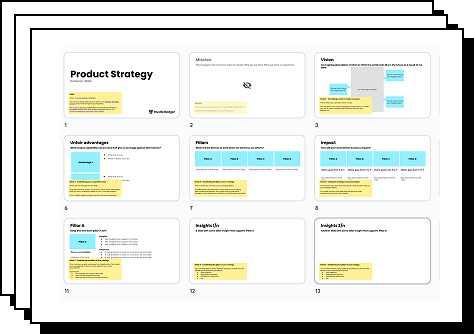In our recent snap strategy class, Ed Biden, co-founder of Hustle Badger demonstrated how to create a product strategy in just one hour. Snap strategies allow you to get your thoughts down early, and start to share and refine them with others to make strategy development iterative and effective.
It’s a practical approach designed to help product leaders and managers streamline their strategy development, making it easier to communicate objectives and align teams.
In this snap strategy class Ed walks you through the why, and the steps to take, to leave you with a draft product strategy at the end after 1 hour of time investment.
Why Create A Snap Strategy
“A strategy helps you focus on the results.”
Ed kicked off the product strategy class by discussing the fundamental reasons for having a strategy in place.
He talked about the fact that many companies fall into the trap of becoming a “feature factory,” where focus is on delivering outputs or executing tasks placed on a backlog by senior or noisy stakeholders without considering their impact. Putting in place a clear product strategy, socialized with the organization, helps redirect product team effort towards results that matter.
This enables teams to work on mutually reinforcing ideas rather than pursuing random high-impact features.
By aligning efforts, teams can achieve greater results, creating a “one plus one equals three” effect.
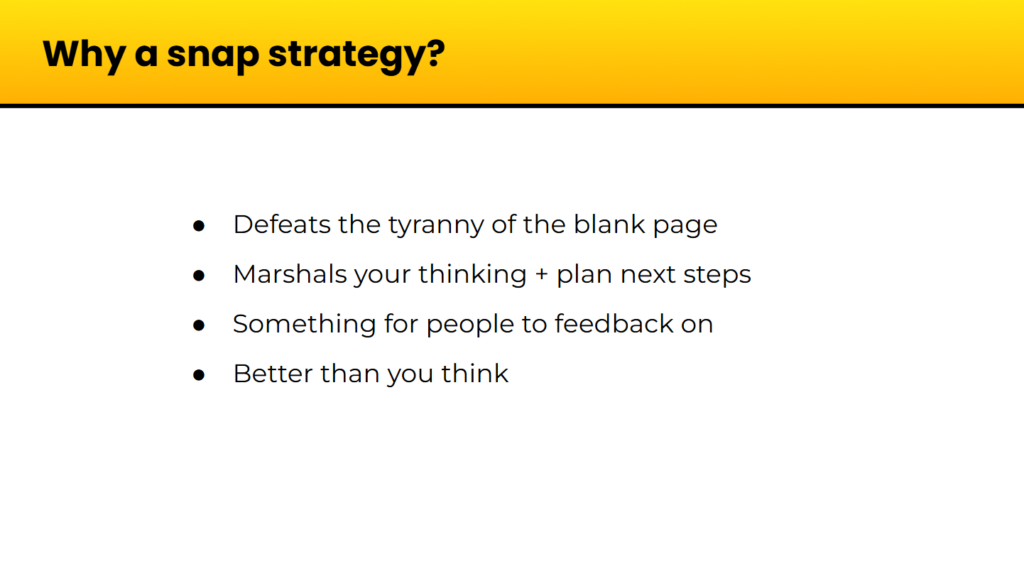
Using a Snap Strategy Template
Next Ed introduced the concept of a Snap Strategy. He explained that this strategy can be developed quickly—typically within an hour or two. It’s essentially a set of notes that helps to kickstart thinking and action.
According to Ed, “It just gets you going, it kind of defeats that blank page and gets you into motion.”
Getting thoughts on paper, even if later discovery means they’re deprioritized or adapted, allows teams to marshal their thoughts and identify gaps or assumptions that require further exploration.
It also provides a basis for feedback from others: you now have a document you can discuss with stakeholders, and start iterating from.
You can use the Hustle Badger Snap Strategy Template to get going.
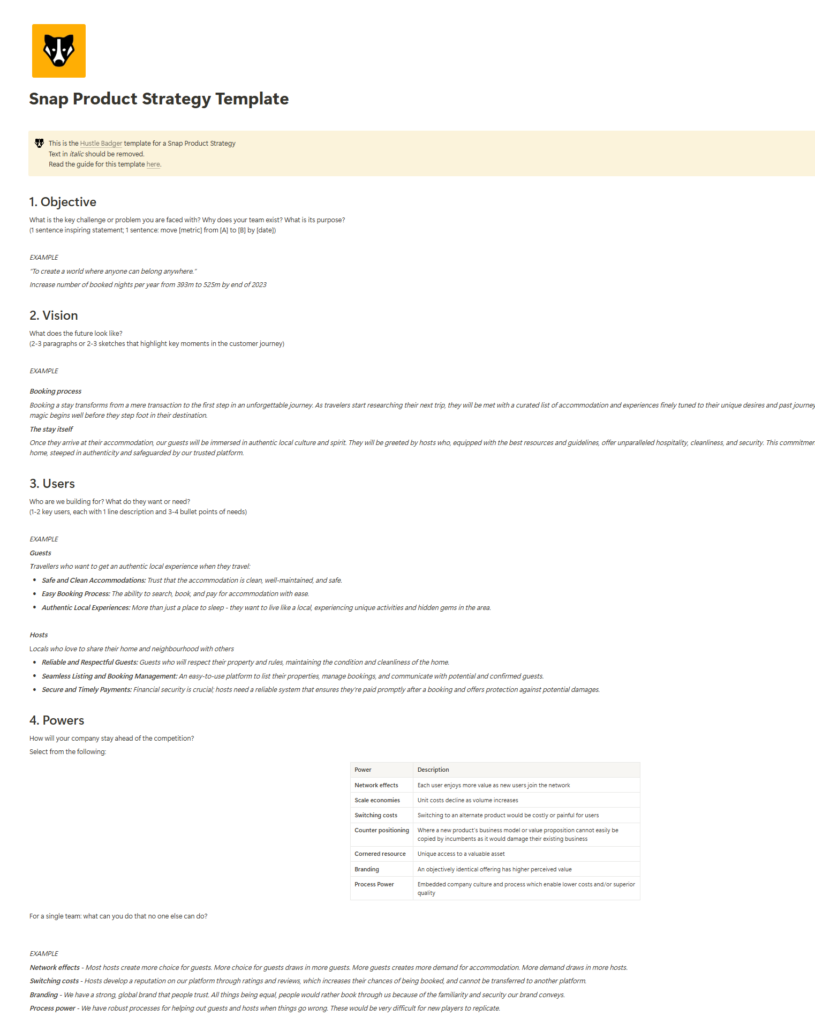
The Hustle Badger Snap Strategy Template
7 Steps to Create A Product Strategy

Read our guide How to write a great product strategy
Step 1: Defining Your Objective
“Without a goal, there is no strategy.”
An objective is a response to the key challenge you fact. It’s a combination of a mission and a measure.
Ed stated that a mission is an inspiring statement that articulates the change you want to see in the world. This serves as a guiding light for your strategy and aligns team efforts.
You need to support your mission with a clear success metric. It’s a way of gauging how much progress you’ve made.
It’s crucial to establish a clear objective that combines both an inspiring mission and measurable metrics to track progress.
Ed encouraged participants to think deeply about their mission at this stage.
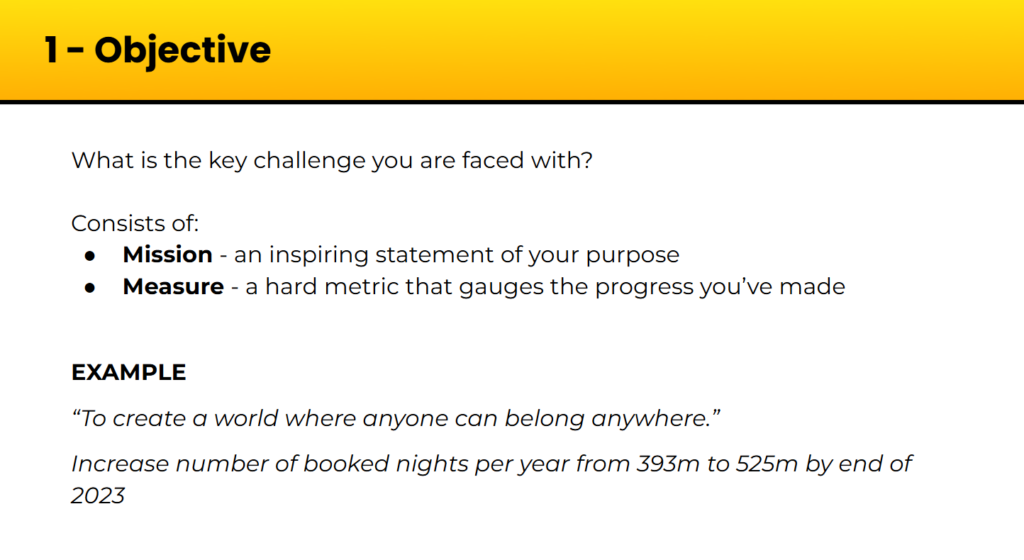
Step 2: Identifying Your Users
It’s important to identify users effectively. Understanding who you are building for is critical. Who are you building for, and why?
Ed urged attendees to consider user needs and pain points as they develop their strategy.
He stated, “You’re not just building a product; you’re solving problems for your users.”
This perspective shifts the focus from product features to user-centric solutions, ensuring that the strategy aligns with real-world needs.
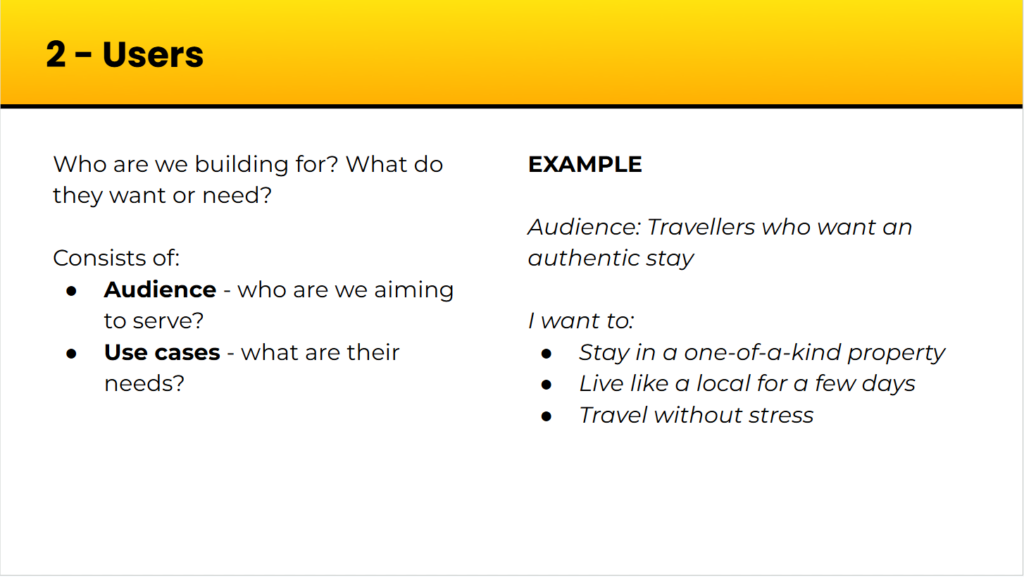
Step 3: Recognizing Your Superpowers
“What can your company do that no one else can do?”
In this section, Ed discussed the concept of “superpowers,” which refer to unique strengths that your company possesses. He encouraged participants to identify what their company can do better than anyone else.
You can select from:
- Network effects – Each user enjoys more value as new users join the network
- Scale economies – Unit costs decline as volume increases
- Switching costs – Switching to an alternate product would be costly or painful for users
- Counter positioning – Where a new product’s business model or value proposition cannot easily be copied by incumbents as it would damage their existing business
- Cornered resource – Unique access to a valuable asset
- Branding – An objectively identical offering has higher perceived value
- Process Power – Embedded company culture and process which enable lower costs and/or superior quality
Recognizing these superpowers helps to shape the strategy and leverage competitive advantages in the market.
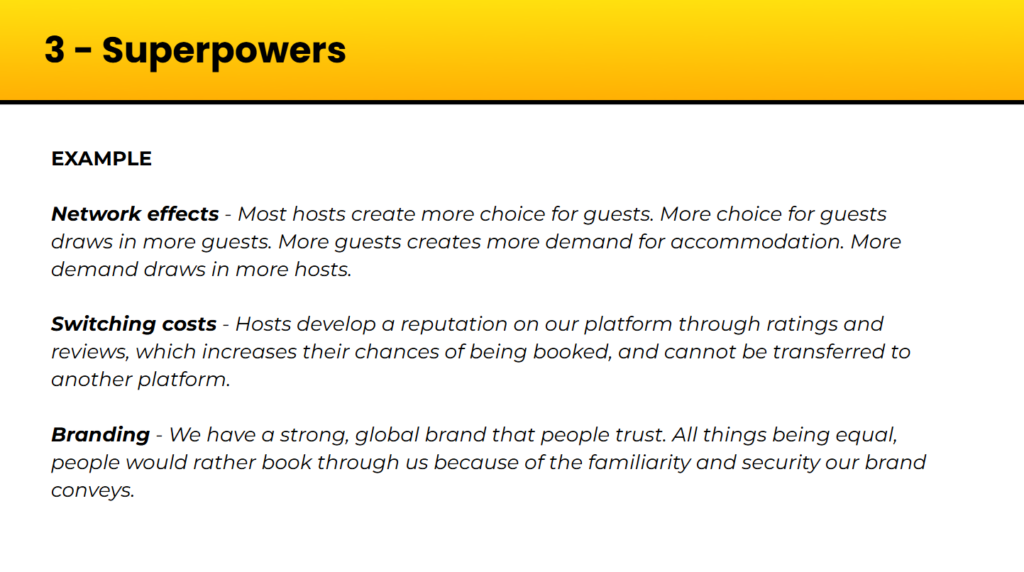
Read our guide to 7 Powers: establishing your competitive moat
Step 4: Crafting Your Vision
Next we came to the importance of crafting a clear and compelling vision for your product. A vision is an articulation of what the future looks like.
Ed explained that a vision acts as a North Star, guiding decisions and actions across the team. A strong vision should resonate with both internal stakeholders and users.
Ed stated, “Your vision should be aspirational yet achievable.”
He encouraged participants to think about the long-term impact they want their product to have and to articulate that in a way that inspires others.
This vision should not only reflect the company’s goals but also address user needs and market trends.
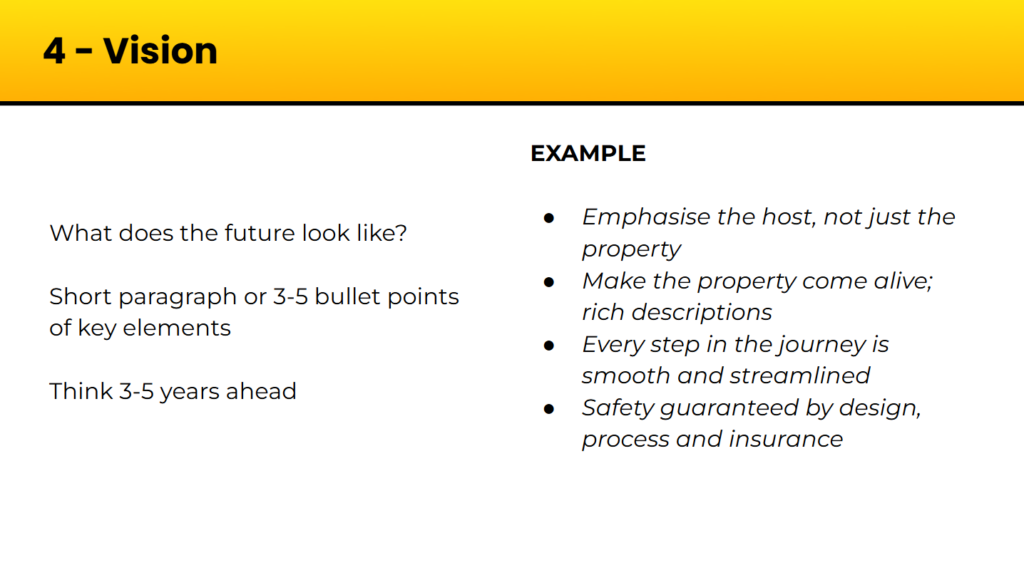
Get Real Product Vision Examples here
Step 5: Establishing Your Pillars
Ed then guided the class through the process of establishing strategic pillars that support the vision. Your pillars are the 2-4 most important themes of work given your Vision, Users and Powers.
They’re essential to underpin the overall strategy, provided you ensure that every initiative aligns with the broader goals.
He explained, “Pillars help you to focus your efforts and resources.”
Each pillar should represent a critical area of focus, whether it is user experience, technology, or market expansion.
Ed encouraged participants to identify three to five pillars that are vital to their strategy, as these will serve as a foundation for future decisions.
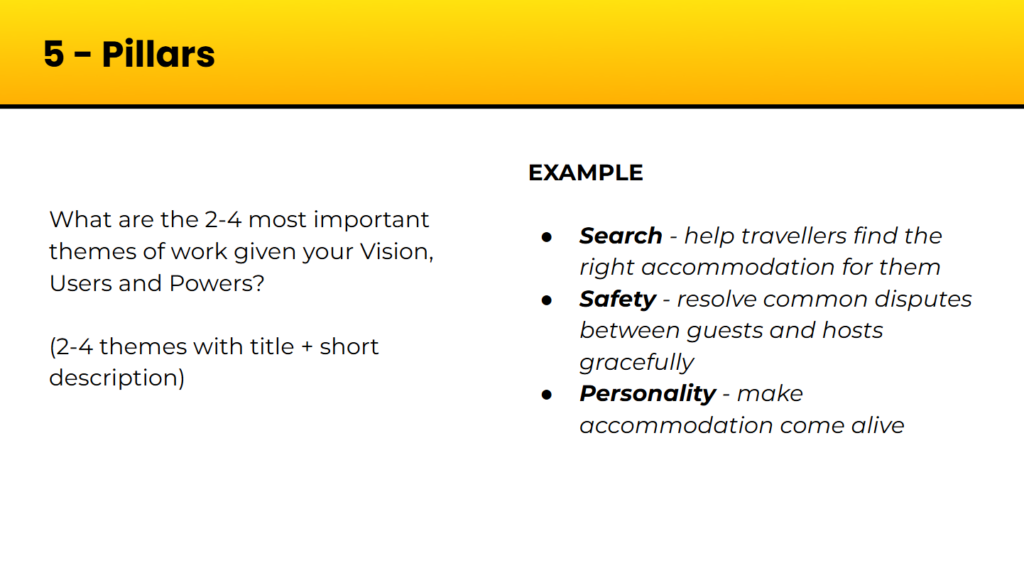
Step 6: Assessing Impact
“It’s not just about what you do; it’s about the difference it makes.”
Strategies aren’t useful if you don’t have a clear idea of whether they’ll meaningfully improve numbers. Sometimes what you think is a big lever turns out not to be, and what you think is a small lever can have big results. Stating the impact you think you will have and supporting it with modelling can help you understand goals and scale better.
In this section, Ed discussed the importance of assessing the potential impact of proposed strategies. Understanding the implications of each decision is essential to make informed choices.
He encouraged participants to consider both short-term and long-term impacts on users, stakeholders, and the market. This assessment helps to prioritize initiatives and allocate resources effectively.
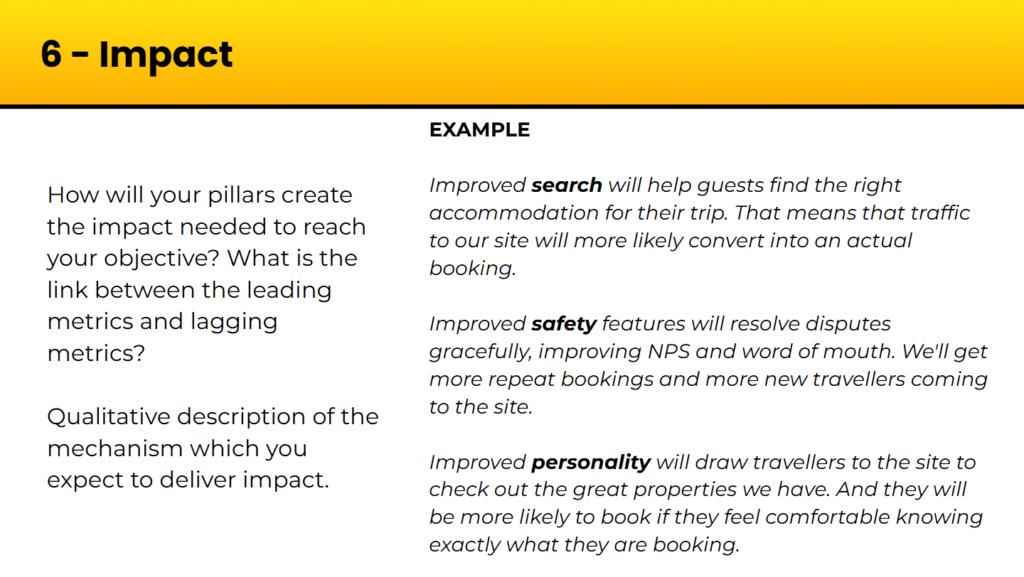
Step 7: Developing Your Roadmap
“A roadmap translates your strategy into actionable steps.”
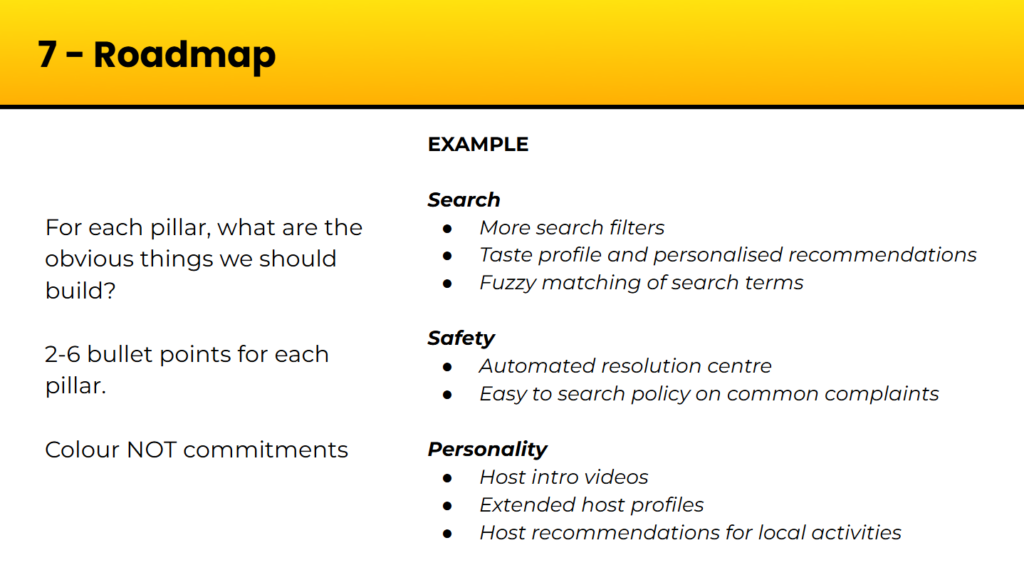
Following the assessment of impact, Ed outlined the process of developing a strategic roadmap.
It’s a specific type of product roadmap template that shows where a product team will allocate its focus and resources, organized by strategic theme.
Ed recommended additionally breaking down the roadmap into phases, highlighting dependencies and timelines.
This approach ensures that all team members are aligned and aware of their responsibilities as they work towards the vision.
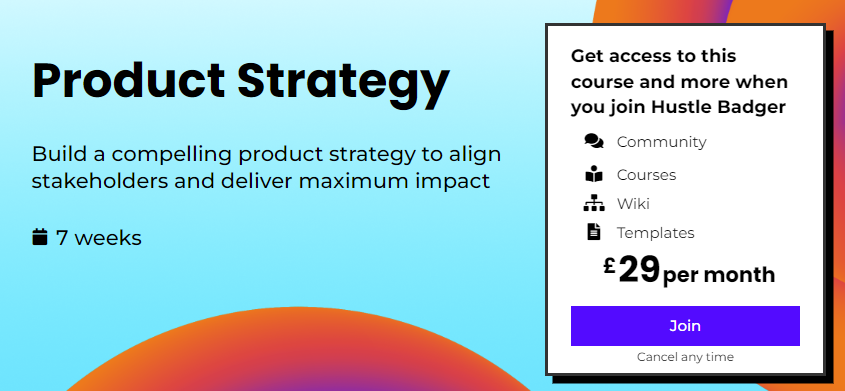
Next: Engaging Stakeholders
“Communication is key to stakeholder engagement.”
Lastly, Ed emphasized the necessity of engaging stakeholders throughout the strategy development process.
He explained that buy-in from key stakeholders is crucial for the successful implementation of any strategy.
He advised participants to actively involve stakeholders in discussions, solicit feedback, and keep them informed of progress. This engagement fosters collaboration and ensures that everyone is working towards a common goal.
One important thing to grasp about a snap strategy is that it’s a stepping stone on the way to developing your larger strategy, but a key one which will help you iterate with stakeholder input towards that goal. Your aim here is to invest 1 hour, put in the time to get your thoughts down, and then start to socialize those thoughts within your organization with a document in place.
By continuously reworking and validating your strategy using the snap strategy document as your starting point you’ll be able to get to a strategy and roadmap that is endorsed and accepted within your company.
At this point you can start developing your snap strategy into a fuller product strategy.
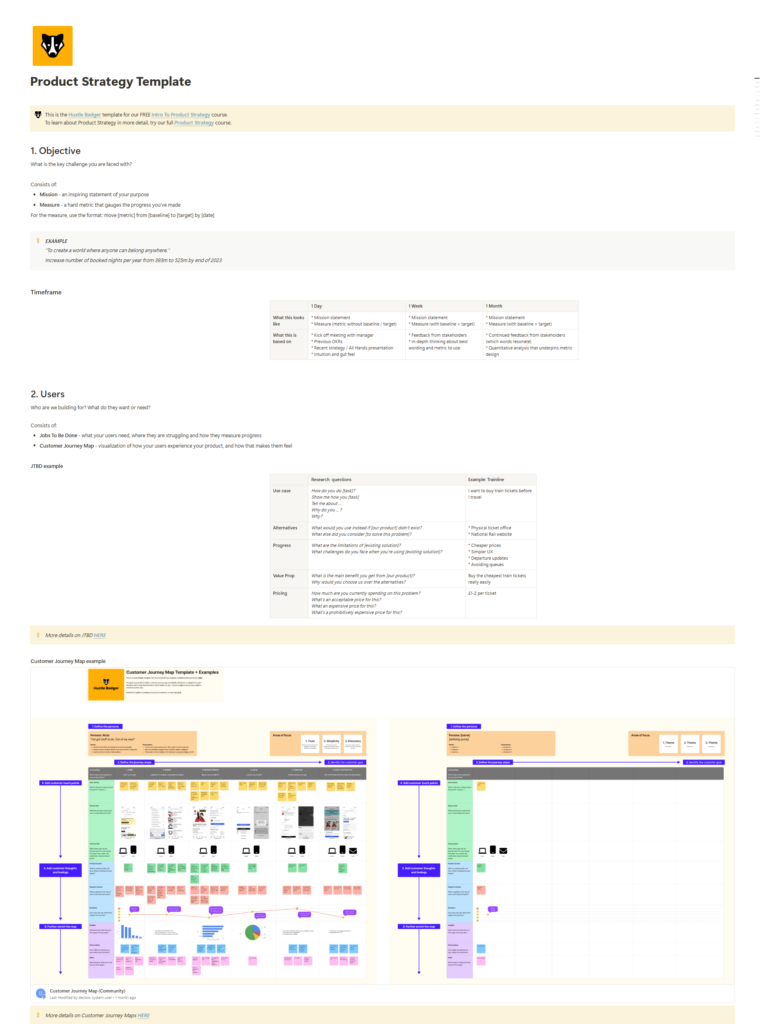
The Hustle Badger Product Strategy Template
Sharing and Feedback
After developing their Snap Strategies, Ed emphasized the importance of sharing these strategies with peers for feedback. “Communication is key to refining your strategy.”
Participants were encouraged to present their strategies in small groups, fostering a collaborative environment where ideas could be exchanged and improved upon.
Ed suggested that teams should be open to receiving constructive criticism and using it to enhance their strategies.
“The more perspectives you gather, the stronger your strategy will become,” he added. This step is crucial for ensuring that the Snap Strategy is not only well-defined but also aligned with the broader objectives of the organization.
Real-Time Application: Creating a Snap Strategy for Tinder
Let’s now see it in action. Ed walked the class through a real-time application of the Snap Strategy, focusing specifically on Tinder.
He encouraged participants to think critically about the unique competitive advantages Tinder possesses. He focused on network effects and branding as core advantages that Tinder possesses.
“The more people you have on the platform, the more selection you have.” Increased user participation leads to greater value for all users.
He also pointed out the importance of branding, noting that “Tinder has broken through to the mainstream in a way that few other dating sites have.”
This strong brand recognition allows Tinder to attract users more effectively than its competitors.
Key Takeaways
Ed wrapped up by summarizing the key takeaways.
He reiterated that the Snap Strategy is a practical tool that can be developed quickly, emphasizing its role in kicking off strategic thinking and action. “You can do this in an hour or give yourself a couple of hours just to get something on paper.”
He encouraged participants to reflect on the steps discussed and to continuously iterate on their strategies. The importance of having a clear mission, understanding user needs, and leveraging competitive advantages were highlighted as essential components of a successful Snap Strategy.
He concluded with a reminder that the Snap Strategy is a living document, meant to evolve as new insights and data are gathered. “This is not a one-time exercise; it’s part of an ongoing process.”
Questions asked and answered in the class
- What if I don’t have a user base to measure against?
Ed suggested thinking about what numbers would make you and your stakeholders happy, even if there are no existing benchmarks. You can sense check these by checking online for publicly available benchmarks by your industry or company type.
- How do I identify users for a new initiative?
Consider who your target audience is and what their needs are. Use use cases to define what users want or need from your product. Do some early stage discovery interviews to supplement this by real feedback.
- Should I consider multiple user groups in my strategy?
Yes, if you serve different user groups, it’s important to think about their unique use cases and how they interact with your product.
- What are strategic pillars?
Strategic pillars are your major focus areas to achieve your strategy’s goals. By narrowing down to 2, max 4 pillars, you can start to prioritize and focus. If you don’t articulate your focus and where you’re placing your bets it’s hard to remain on track to deliver your product vision.
- How can I ensure stakeholder engagement?
A snap strategy is an iterative process. Put one together. Share it for feedback in an inner circle. Iterate and then share again with cross functional and senior stakeholders. Iterate. This process will help you get to a robust strategy for a longer period which is agreed and endorsed by your organization.
- How can I create a Snap Strategy for a portfolio of products?
Ed suggested focusing on the overall objectives of the portfolio and adapting the Snap Strategy framework to fit those goals. Each product may have its own individual strategy, but the portfolio should align with a common purpose.
- What if my product is highly technical with no clear UI?
Ed recommended using visual aids such as system diagrams or storyboards to illustrate the improvements and user journey, even if the UI isn’t the focal point.
- Can the Snap Strategy be used for ongoing projects?
Absolutely. Ed encouraged using the Snap Strategy as a framework for continuous improvement, stating, “It’s meant to be dynamic and evolve with your insights and data.”
- What if stakeholders disagree with the strategy? Ed advised that it’s essential to listen to their concerns and incorporate valid feedback into the strategy. This collaborative process can lead to a more robust plan.
- How can I ensure my Snap Strategy remains adaptable? Regularly reviewing and updating the strategy based on new insights and stakeholder feedback is vital. This keeps the strategy relevant.
- Can group-oriented sessions be conducted remotely? Yes, Ed highlighted that remote collaboration tools can facilitate effective group sessions, allowing teams to work together regardless of location.
Hustle Badger Resources
[Video & Slides]
[Templates]
[Articles]
[Courses]
[Classes]



